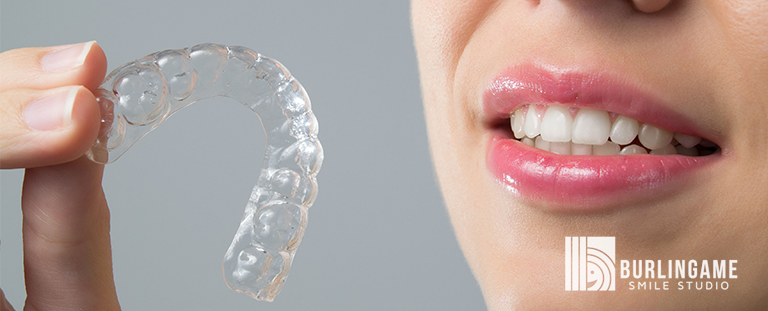Overview
There are two basic types of retainers: removable and permanent. Dr. April Lee of Burlingame Smile Studio will help you choose the best type for you based on what you needed braces for and any conditions you might have. You may receive both a removable retainer for your top teeth and a permanent one for your bottom teeth.
A retainer keeps your teeth from moving after they’ve been straightened with braces. It can take at around 4 to 6 months for the new position of your teeth to remain stable. Prior to that, your teeth will constantly try to shift back to their original position, which is called “relapse.” When used as instructed, a retainer prevents this from happening.
Removable retainers
The Pros of removable retainers are:
- Easily removable when you want to eat or clean your teeth.
- Overall, they are pretty convenient to get.
The Cons are:
- Easily misplaced or lost when not in your mouth.
- Easily damaged if left lying around.
- Can cause excess saliva production.
- Bacteria can grow easily on them.
The biggest problem with removable retainers is the common relapse. This is because people may lose the retainer and not replace it or don’t wear their retainer as often as instructed.
Both types of removable retainers should be removed and cleaned with gentle brushing daily. Your orthodontist may also recommend soaking it to clean.
There are two kinds of removable retainers: Hawley and clear plastic retainers.
Hawley retainers
Hawley’s are also called wire retainers; these are removable retainers made of thin metal wire and plastic or acrylic shaped to fit the roof of your mouth or your lower teeth. An attached metal wire runs across the outside of your teeth to keep steady alignment.
Pros of the Hawley retainer are:
- It can be adjusted if you need a better fit on the fly.
- A bit more durable than a clear plastic version.
- Can be repaired if broken.
- Can last for years if cared for.
- The upper and lower teeth touch naturally.
Cons are:
- Can affect your speech more than other retainers.
- Is more noticeable than the other types of retainers.
- The wire can irritate your lips or cheeks.
Clear plastic retainers
These are removable and are molded to perfectly fit the new position of your teeth. To make this type of retainer, a mold of the teeth is created. Very thin plastic or polyurethane is then heated and sucked down around the mold.
Pros of a clear plastic retainer:
- Invisible, so you’re more likely to wear it and relapse is less likely.
- More comfortable than a Hawley retainer.
- Doesn’t affect your speech than a Hawley retainer.
Cons of a clear retainer:
- Cannot be re-adjusted, would need to be replaced.
- Cannot be repaired.
- Can affect your speech more than permanent retainers.
- May warp if exposed to heat.
- Can become discolored over time.
- Top and bottom teeth don’t touch naturally.
- Can trap liquids and can cause cavities.
The main difference among the three common brands of clear retainers is the type of plastic material they are made of. The brands are Vivera, Essix, and Zendura.
Clear plastic retainers have become more and more popular and are used more often than Hawley retainers. The average cost varies for each tray, upper and lower.
Contact Burlingame Smile Studio, serving Burlingame, Hillsborough, and Millbrae.
(650) 231-2680
Location (Tap to open in Google Maps):
1740 Marco Polo Way Ste 12
Burlingame, California
94010

